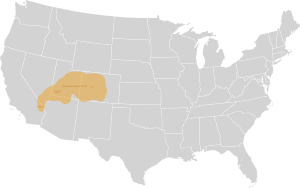Colorado River Numic language facts for kids
Quick facts for kids Colorado River Numic |
||||
|---|---|---|---|---|
| Southern Paiute | ||||
| Native to | United States | |||
| Region | Nevada, California, Utah, Arizona, Colorado, New Mexico | |||
| Ethnicity | 6,200 Chemehuevi, Southern Paiute and Ute (2007) | |||
| Native speakers | 920 (2007)e18 20 monolinguals (1990 census) |
|||
| Language family |
Uto-Aztecan
|
|||
| Dialects |
Chemehuevi
Southern Paiute
|
|||
 |
||||
|
||||
Colorado River Numic is a Native American language. It is also known as Ute, Southern Paiute, or Ute-Chemehuevi. This language is part of the Numic family, which is a branch of the larger Uto-Aztecan language family.
The language is spoken across a wide area. It stretches from southeastern California all the way to Colorado. It is spoken by different groups of people, including the Chemehuevi, Southern Paiute, and Ute. In 2007, about 920 people spoke Colorado River Numic.
The Southern Paiute dialect is famous in the world of linguistics. A well-known linguist named Edward Sapir and his helper Tony Tillohash studied it. Their work helped us understand more about how sounds work in languages.
Contents
Understanding the Dialects
The Colorado River Numic language has three main types, called dialects. These are Chemehuevi, Southern Paiute, and Ute. Even though they are different, they are very similar. Think of them like different accents or versions of the same language.
The differences between these dialects are mostly about culture. But there are also a few sound differences. For example:
- In Southern Paiute and Ute, the "h" sound at the beginning of some words has disappeared. So, a word like "drink" might start with "h" in Chemehuevi, but not in the other dialects.
- In Ute, certain sound combinations have changed. For example, sounds like "nk" might become a double "kk" sound.
- In Ute, a specific "o" sound has changed to an "ö" sound.
These sound changes happen more and more as you move from the Southern Paiute areas to the Ute areas.
How Sounds Work (Phonology)
Every language has its own set of sounds. This is called its phonology. Colorado River Numic has different sounds for consonants and vowels.
Consonant Sounds
Consonants are sounds made by blocking air in your mouth. Think of sounds like "p," "t," or "m." The Chemehuevi and Southern Ute dialects have slightly different consonant sounds. For example, some sounds that are present in Chemehuevi might not be in Southern Ute.
Vowel Sounds
Vowels are sounds made with an open mouth, like "a," "e," "i," "o," "u." In Colorado River Numic, vowels can be long or short. Sometimes, short vowels that are not stressed can be spoken very softly, almost like they disappear.
How Words Are Built (Morphology)
Colorado River Numic is an agglutinative language. This means that words are built by adding many small parts, called morphemes, to a base word. Each small part adds a specific meaning. It's like adding building blocks to create a complex word. This allows words to carry a lot of information.
See also

